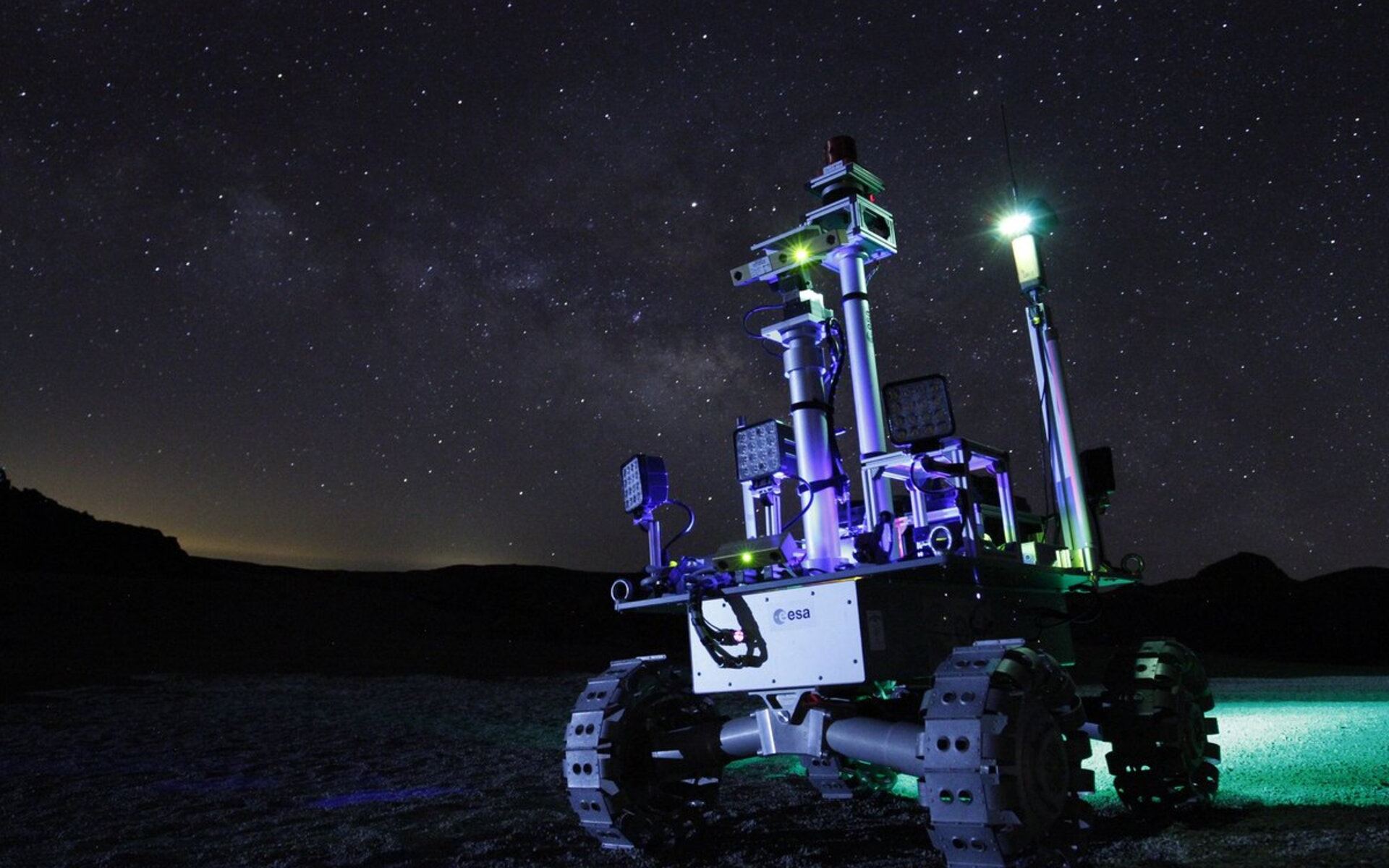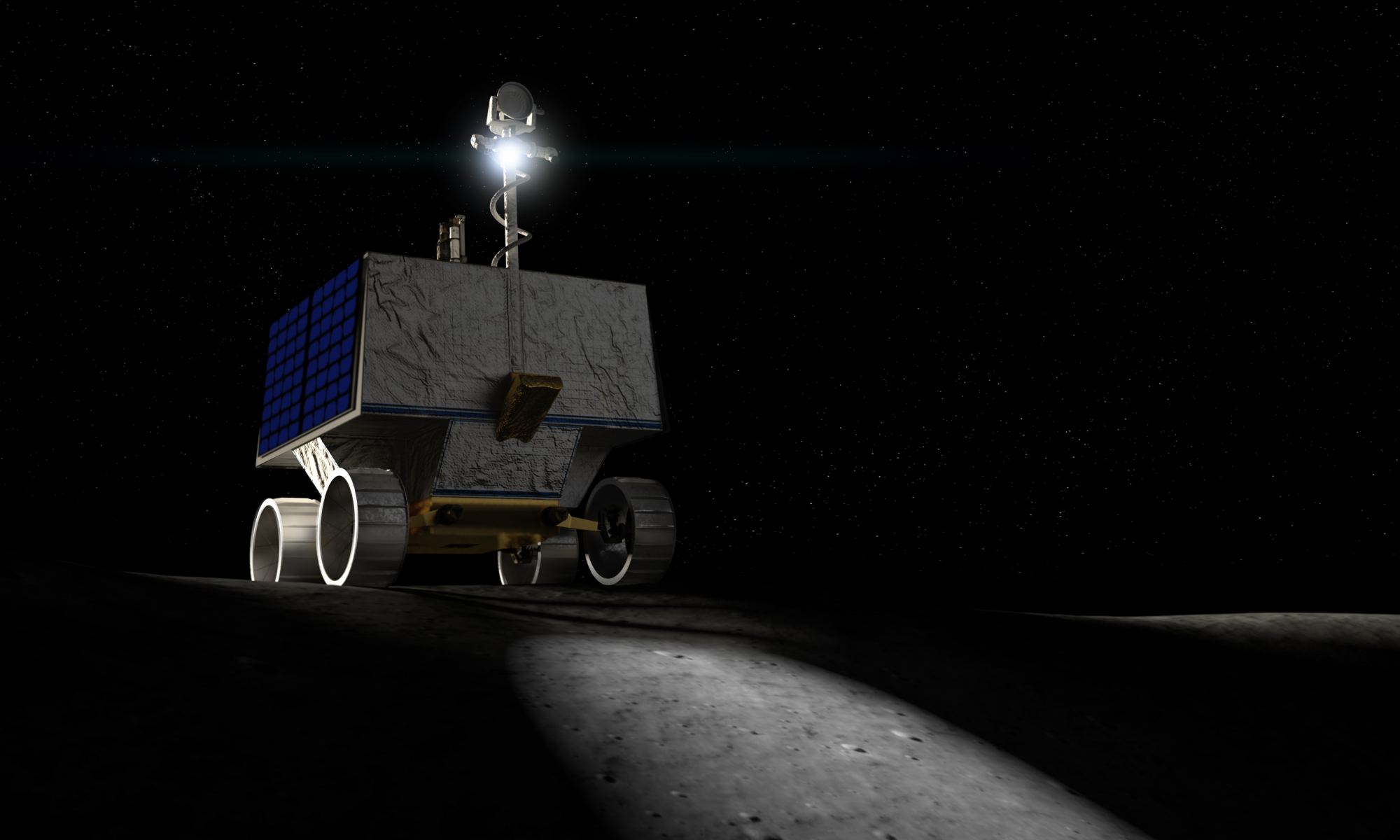The craters on the Moon’s poles are in permanent shadow. But they’re also intriguing locations, due to deposits of water ice and other materials. The ESA is developing the idea for a rover that can explore these areas with power provided by lasers.
Continue reading “This Laser Powered Rover Could Stay in the Shadows on the Moon and Continue to Explore”Mapping Out the Water on the Moon
In 2009, NASA launched the Lunar Reconnaissance Orbiter (LRO), the first mission to be sent by the US to the Moon in over a decade. Once there, the LRO conducted observations that led to some profound discoveries. For instance, in a series of permanently-shaded craters around the Moon’s South Pole-Aitken Basin, the probe confirmed the existence of abundant water ice.
Based on the temperature data obtained by the LRO of the Moon’s southern polar region, the ESA recently released a map of lunar water ice (see animation below) that will be accessible to future missions. This includes the ESA’s Package for Resource Observation and in-Situ Prospecting for Exploration, Commercial exploitation and Transportation (PROSPECT), which will be flown to the Moon by Russia’s Luna-27 lander in 2025.
Continue reading “Mapping Out the Water on the Moon”Beyond Robotic Arms. Canada Funds Technology for Space Exploration

The Canadian Space Agency (CSA) has a long-standing tradition of innovation and technological development in space. Who can forget the Shuttle Remote Manipulator System (SRMS), more familiarly known as the “Canadarm“, which was essential to the Space Shuttle program? How about its successor, the Canadarm2, which is a crucial part of the International Space Station and even helped assemble it?
Looking to the future, the CSA intends to play a similar role in humanity’s return to the Moon – which includes the creation of the Lunar Gateway and Project Artemis. To this end, the CSA recently awarded a series of contracts with private businesses and one university to foster the development of technologies that would assist with national and international efforts to explore the Moon.
Continue reading “Beyond Robotic Arms. Canada Funds Technology for Space Exploration”NASA is Planning to Build a Lunar Rover With a 1-Meter Drill to Search for Water Ice
Meet VIPER, NASA’s new lunar rover, equipped with a drill to probe the Moon’s surface and look for water ice. VIPER, or Volatiles Investigating Polar Exploration Rover, will carry a one-meter drill and will use it to map out water resources at the Moon’s south pole. It’s scheduled to be on the lunar surface by December 2023, one year later than it’s initial date.
Continue reading “NASA is Planning to Build a Lunar Rover With a 1-Meter Drill to Search for Water Ice”China’s Yutu-2 Rover has now Traveled Over 345 Meters Across the Surface of the Moon
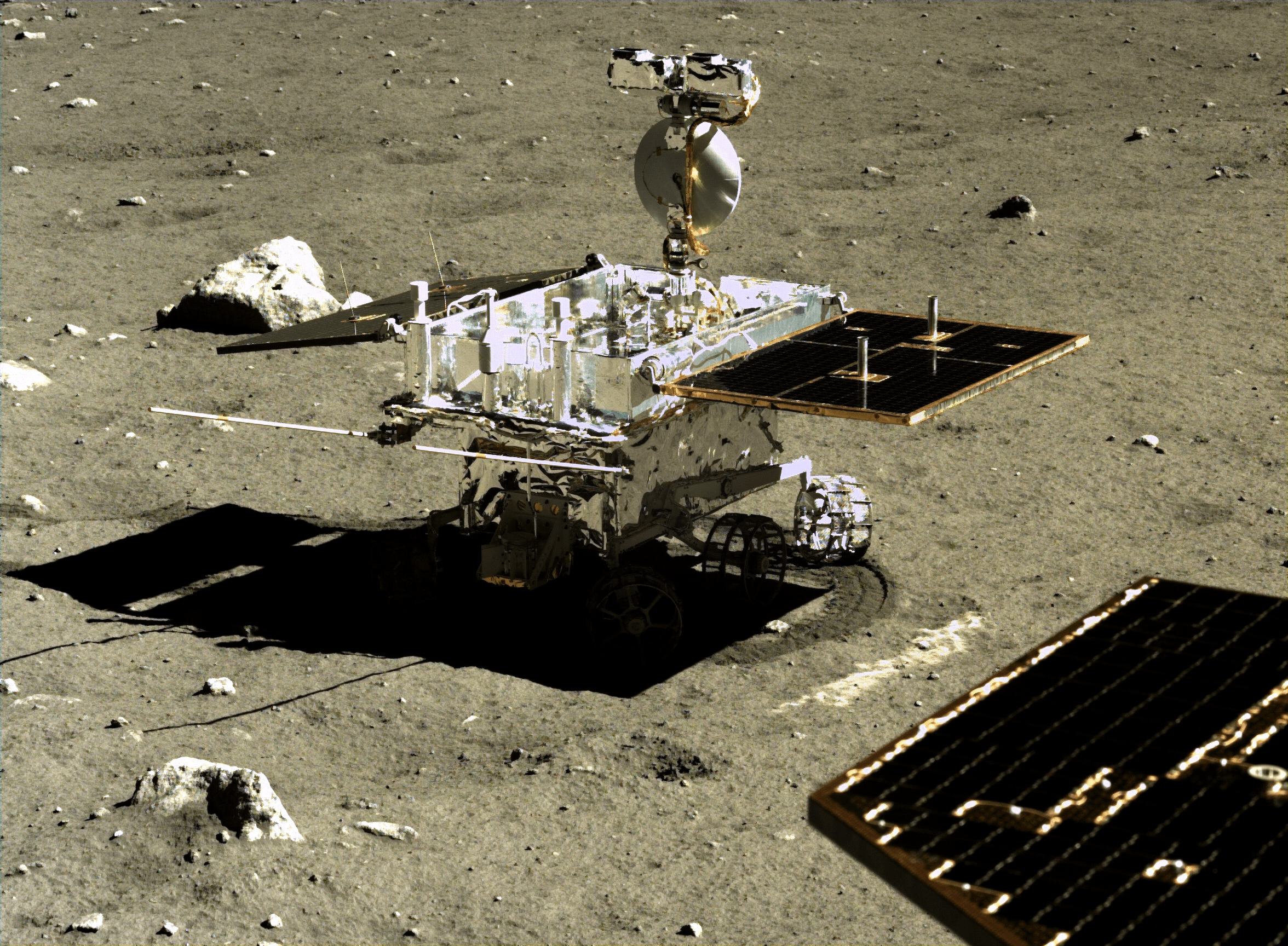
On January 3rd, 2019, China’s Chang’e-4 lander became the first mission in history to make a soft-landing on the far side of the Moon. After setting down in the Von Karman Crater in the South Pole-Aitken Basin, the rover element of the mission (Yutu 2) deployed and began exploring the lunar surface. In that time, the rover has traveled a total of 345.059 meters (377 yards) through previously unexplored territory.
Continue reading “China’s Yutu-2 Rover has now Traveled Over 345 Meters Across the Surface of the Moon”NASA is Testing a Rover That Could Search For Water Ice on The Moon
In the coming years, NASA will be sending astronauts back to the Moon for the first time since the last Apollo mission took place in 1972. Back in May, NASA announced that the plan – which is officially known as Project Artemis – was being expedited and would take place in the next five years. In accordance with the new timeline, Artemis will involve sending the first woman and next man to the Moon’s southern polar region by 2024.
To this end, NASA is working on a lunar rover that will search for and map out water deposits in the Moon’s southern polar region. It’s known as the Volatiles Investigating Polar Exploration Rover (VIPER) and it is scheduled to be delivered to the lunar surface by 2022. This mission will gather data that will help inform future missions to the South Pole-Aitken Basin and the eventual construction of a base there.
Continue reading “NASA is Testing a Rover That Could Search For Water Ice on The Moon”Dust off Your Lunar Colony Plans. There’s Definitely Ice at the Moon’s Poles.
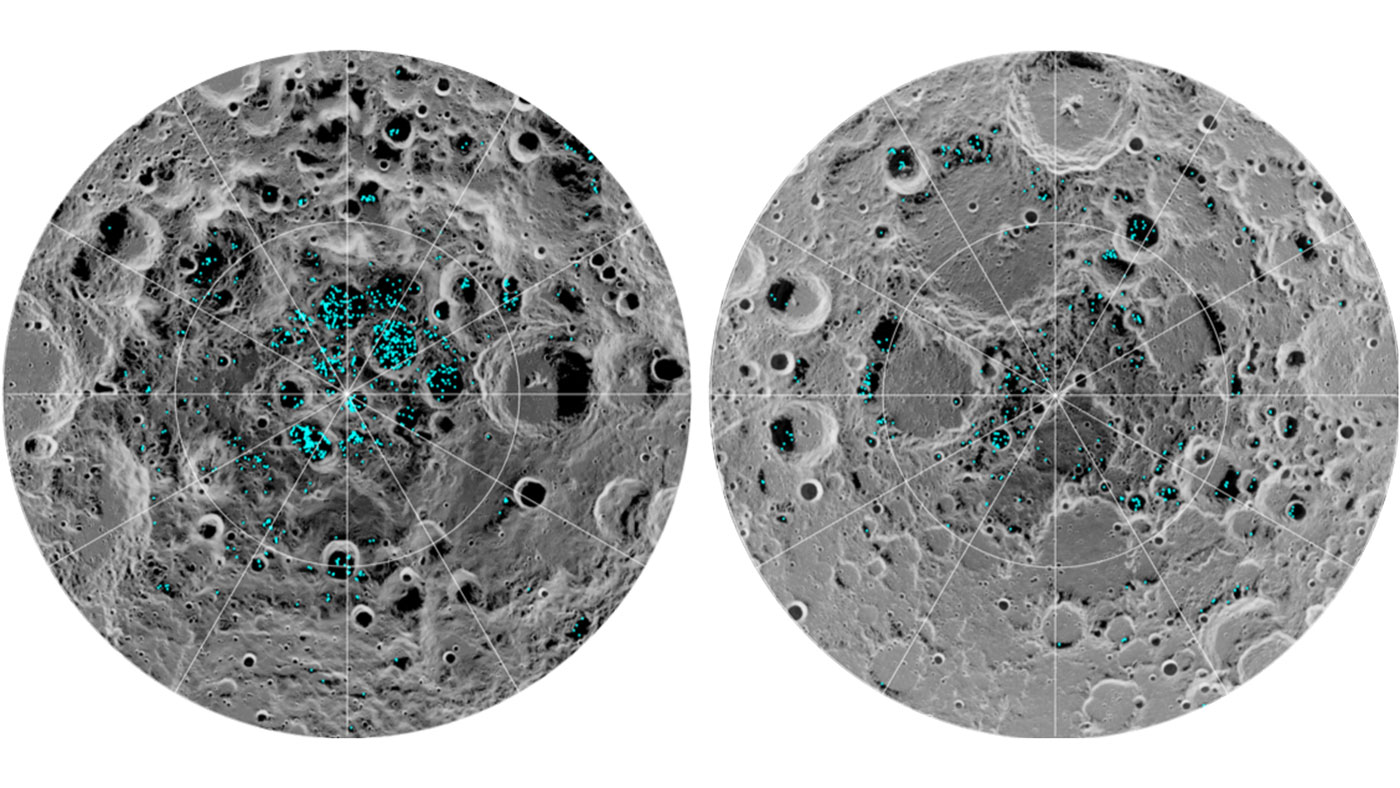
When it comes right down to it, the Moon is a pretty hostile environment. It’s extremely cold, covered in electrostatically-charged dust that clings to everything (and could cause respiratory problems if inhaled), and its surface is constantly bombarded by radiation and the occasional meteor. And yet, the Moon also has a lot going for it as far as establishing a human presence there is concerned.
Continue reading “Dust off Your Lunar Colony Plans. There’s Definitely Ice at the Moon’s Poles.”
Was There a Time When the Moon was Habitable?
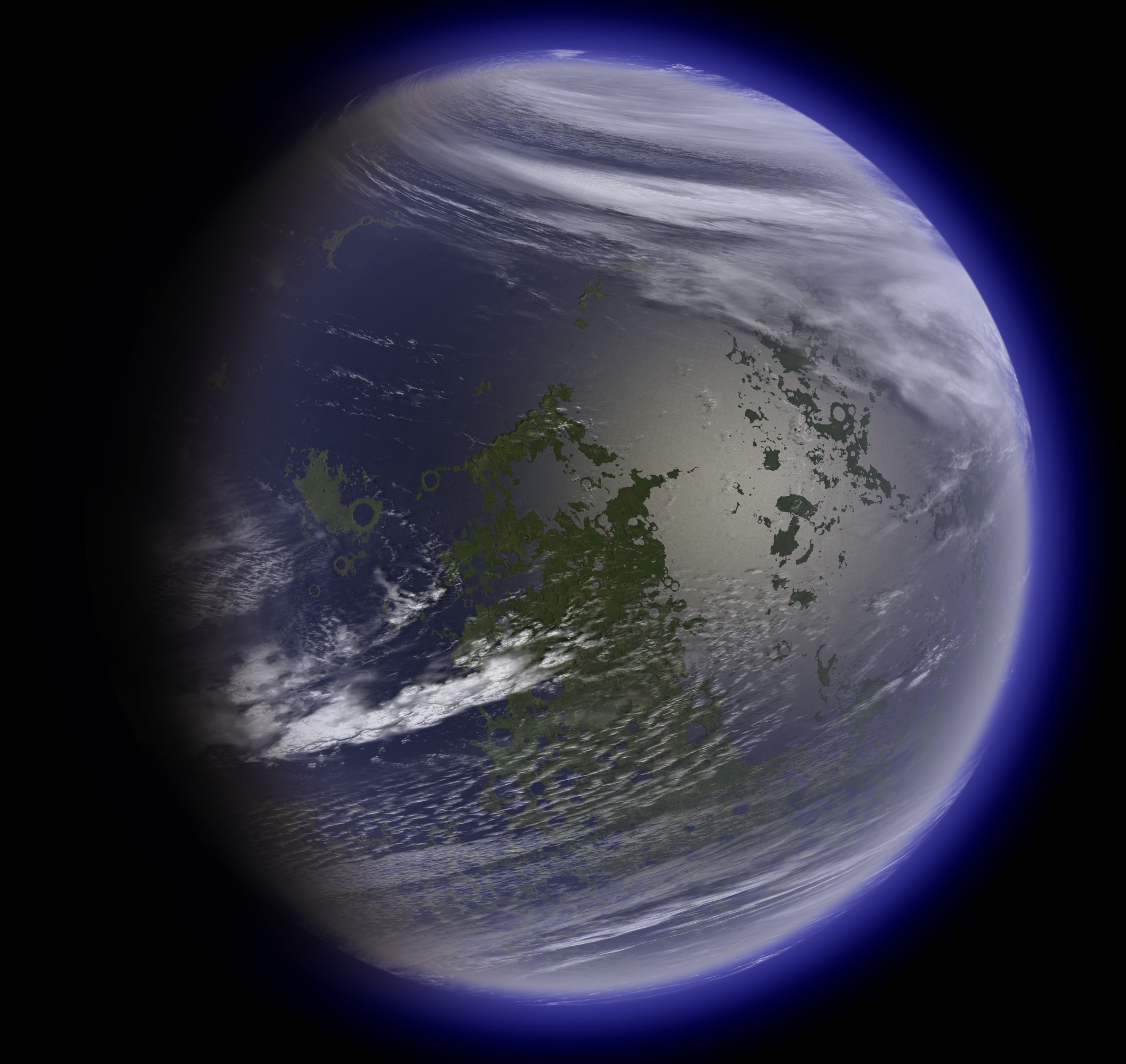
To put it simply, the Earth’s Moon is a dry, airless place where nothing lives. Aside from concentrations of ice that exist in permanently-shaded craters in the polar regions, the only water on the moon is believed to exist beneath the surface. What little atmosphere there is consists of elements released from the interior (some of which are radioactive) and helium-4 and neon, which are contributed by solar wind.
However, astronomers have theorized that there may have been a time when the Moon might have been inhabitable. According to a new study by an astrophysicist and an Earth and planetary scientist, the Moon may have had two early “windows” for habitability in the past. These took place roughly 4 billion years ago (after the Moon formed) and during the peak in lunar volcanic activity (ca. 3.5 billion years ago).
Continue reading “Was There a Time When the Moon was Habitable?”Study of Moon Rocks Suggest Interior of the Moon is Really Dry
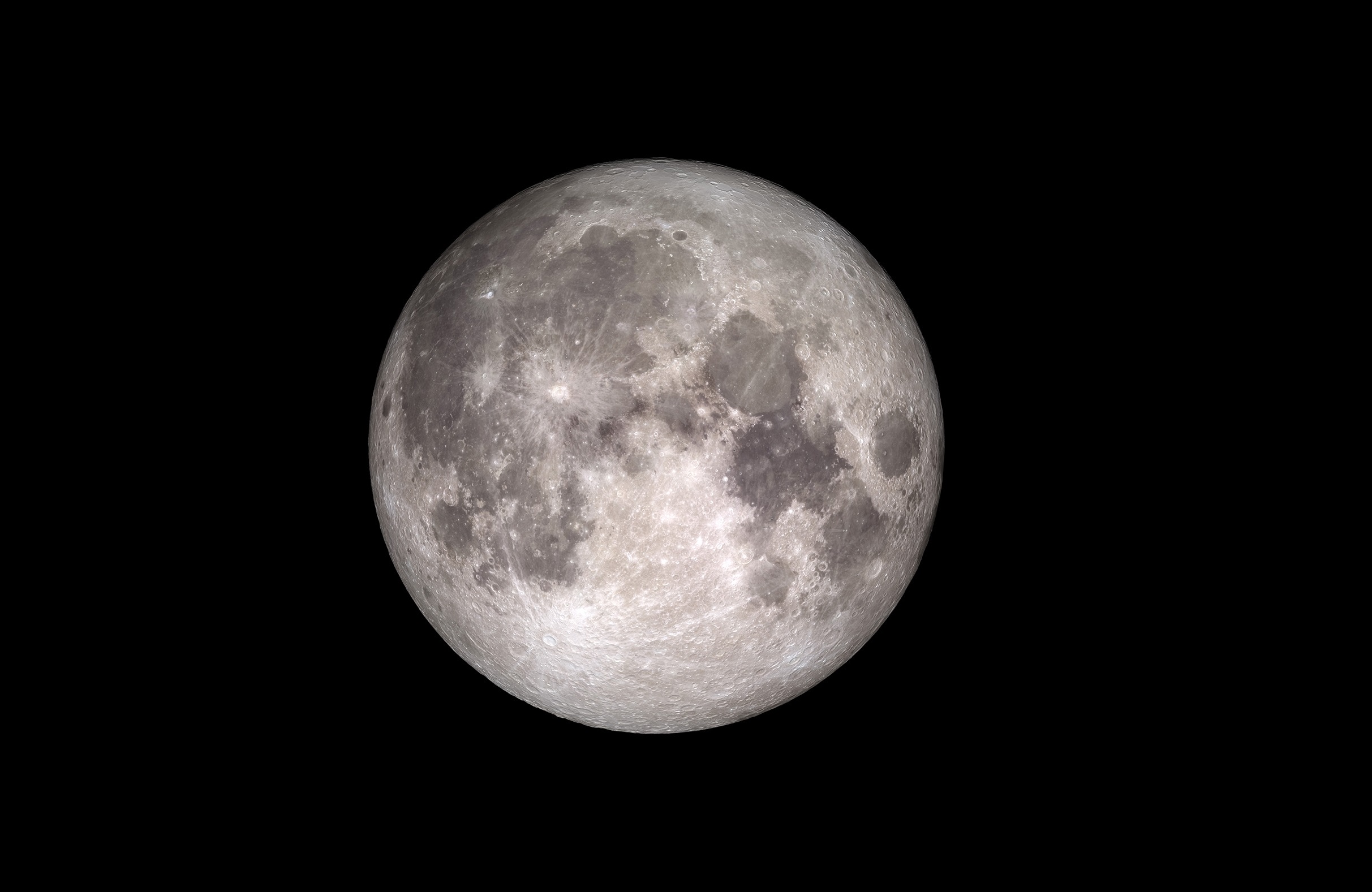
Long before the Apollo missions reached the Moon, Earth’s only satellites has been the focal point of intense interest and research. But thanks to the samples of lunar rock that were returned to Earth by the Apollo astronauts, scientists have been able to conduct numerous studies to learn more about the Moon’s formation and history. A key research goal has been determining how much volatile elements the Moon possesses.
Intrinsic to this is determining how much water the Moon possesses, and whether it has a “wet” interior. If the Moon does have abundant sources of water, it will make establishing outposts there someday much more feasible. However, according to a new study by an international team of researchers, the interior of the Moon is likely very dry, which they concluded after studying a series of “rusty” lunar rock samples collected by the Apollo 16 mission.
The study, titled “Late-Stage Magmatic Outgassing from a Volatile-Depleted Moon“, appeared recently in the Proceedings of the National Academy of Sciences. Led by James M. D. Day of the Scripps Institution of Oceanography at the University of California, San Diego, the team’s research was funded by the NASA Emerging Worlds program – which finances research into the Solar System’s formation and early evolution.
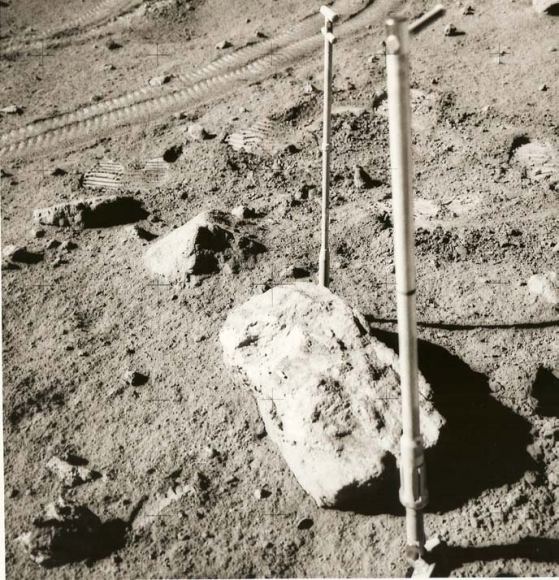
Determining how rich the Moon is in terms of volatile elements and compounds – such as zinc, potassium, chlorine, and water – is important because it provides insight into how the Moon and Earth formed and evolved. The most-widely accepted theory is that Moon is the result of “catastrophic formation”, where a Mars-sized object (named Theia) collided with Earth about 4.5 billion years ago.
The debris kicked up by this impact eventually coalesced to form the Moon, which then moved away from Earth to assume its current orbit. In accordance with this theory, the Moon’s surface would have been an ocean of magma during its early history. As a result, volatile elements and compounds within the Moon’s mantle would have been depleted, much in the same way that the Earth’s upper mantle is depleted of these elements.
As Dr. Day explained in a Scripps Institution press statement:
“It’s been a big question whether the moon is wet or dry. It might seem like a trivial thing, but this is actually quite important. If the moon is dry – like we’ve thought for about the last 45 years, since the Apollo missions – it would be consistent with the formation of the Moon in some sort of cataclysmic impact event that formed it.”
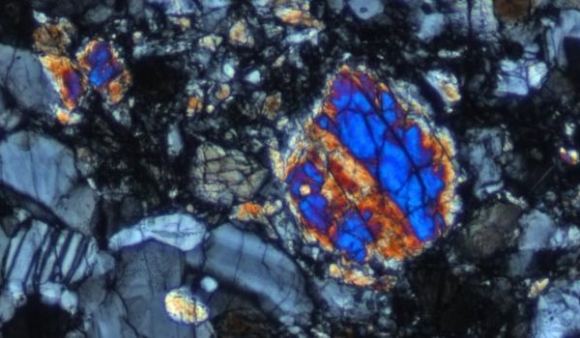
For the sake of their study, the team examined a lunar rock named “Rusty Rock 66095” to determine the volatile content of the Moon’s interior. These rocks have mystified scientists since they were first brought back by the Apollo 16 mission in 1972. Water is an essential ingredient to rust, which led scientists to conclude that the Moon must have an indigenous source of water – something which seemed unlikely, given the Moon’s extremely tenuous atmosphere.
Using a new chemical analysis, Day and his colleagues determined the levels of istopically light zinc (Zn66) and heavy chlorine (Cl37), as well as the levels of heavy metals (uranium and lead) in the rock. Zinc was the key element here, since it is a volatile element that would have behaved somewhat like water under the extremely hot conditions that were present during the Moon’s formation.
Ultimately, the supply of volatiles and heavy metals in the sample support the theory that volatile enrichment of the lunar surface occurred as a result of vapor condensation. In other words, when the Moon’s surface was still an ocean of hot magma, its volatiles evaporated and escaped from the interior. Some of these then condensed and were deposited back on the surface as it cooled and solidified.
This would explain the volatile-rich nature of some rocks on the lunar surface, as well as the levels of light zinc in both the Rusty Rock samples and the previously-studied volcanic glass beads. Basically, both were enriched by water and other volatiles thanks to extreme outgassing from the Moon’s interior. However, these same conditions meant that most of the water in the Moon’s mantle would have evaporated and been lost to space.

Image credit: ISRO/NASA/JPL-Caltech/Brown Univ./USGS
This represents something of a paradox, in that it shows how rocks that contain water were formed in a very dry, interior part of the Moon. However, as Day indicated, it offers a sound explanation for an enduring lunar mystery:
“I think the Rusty Rock was seen for a long time as kind of this weird curiosity, but in reality, it’s telling us something very important about the interior of the moon. These rocks are the gifts that keep on giving because every time you use a new technique, these old rocks that were collected by Buzz Aldrin, Neil Armstrong, Charlie Duke, John Young, and the Apollo astronaut pioneers, you get these wonderful insights.”
These results contradict other studies that suggest the Moon’s interior is wet, one of which was recently conducted by researchers at Brown University. By combining data provided by Chandrayaan-1 and the Lunar Reconnaissance Orbiter (LRO) with new thermal profiles, the Brown research team concluded that lots of water exists within volcanic deposits on the Moon’s surface, which could also mean there are vast quantities of water in the Moon’s interior.
To these, Day emphasized that while these studies present evidence that water exists on the lunar surface, they have yet to offer a solid explanation for what mechanisms deposited it on the surface. Day and his colleague’s study also flies in the face of other recent studies, which claim that the Moon’s water came from an external source – either by comets which deposited it, or from Earth during the formation of the Earth-Moon system.
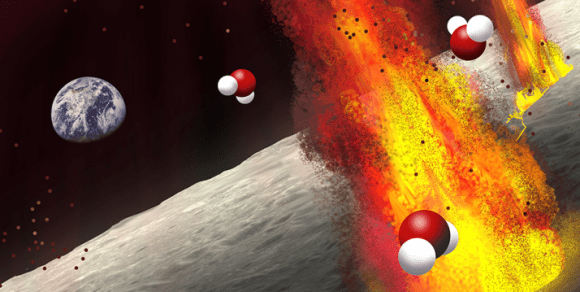
Those who believe that lunar water was deposited by comets cite the similarities between the ratios of hydrogen to deuterium (aka. “heavy hydrogen”) in both the Apollo lunar rock samples and known comets. Those who believe the Moon’s water came from Earth, on the other hand, point to the similarity between water isotopes on both the Moon and Earth.
In the end, future research is needed to confirm where all of the Moon’s water came from, and whether or not it exists within the Moon’s interior. Towards this end, one of Day’s PhD students – Carrie McIntosh – is conducting her own research into the lunar glass beads and the composition of the deposits. These and other research studies ought to settle the debate soon enough!
And not a moment too soon, considering that multiple space agencies hope to build a lunar outpost in the upcoming decades. If they hope to have a steady supply of water for creating hydrazene (rocket fuel) and growing plants, they’ll need to know if and where it can be found!
Further Reading: UC San Diego, PNAS
Good News for Future Moon Bases. There’s Water Inside the Moon
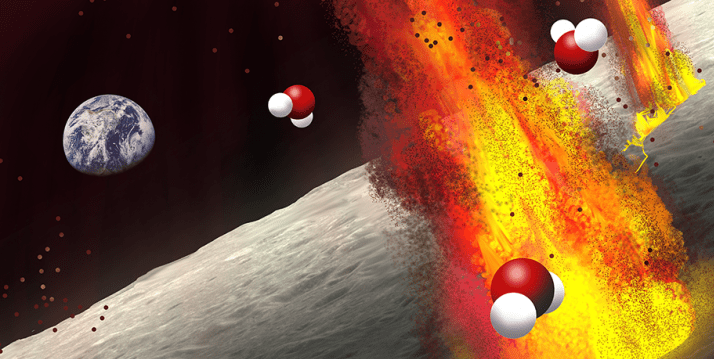
Since the Apollo program wrapped up in the early 1970s, people all around the world have dreamed of the day when we might return to the Moon, and stay there. And in recent years, however, that actual proposals for a lunar settlement have begun to take shape. As a result, a great deal of attention and research has been focused on whether or not the Moon has indigenous sources of water.
Thanks to missions like Chandrayaan-1 and the Lunar Reconnaissance Orbiter (LRO), scientists know that there are vast amounts of surface ice on the Moon. However, according to a new study, researchers from Brown University have found evidence of widespread water within volcanic deposits on the lunar surface. These findings could indicate that there are also vast sources of water within the Moon’s interior.
For their study – titled “Remote Detection of Widespread Indigenous Water in Lunar Pyroclastic Deposits” – Brown researchers Ralph E. Milliken and Shuai Li combined satellite data with new thermal profiles to search for signs of water away from the polar regions. In so doing, they addressed a long-standing theory about the likelihood of water in the Moon’s interior, as well as the predominant theory of how the Moon formed.
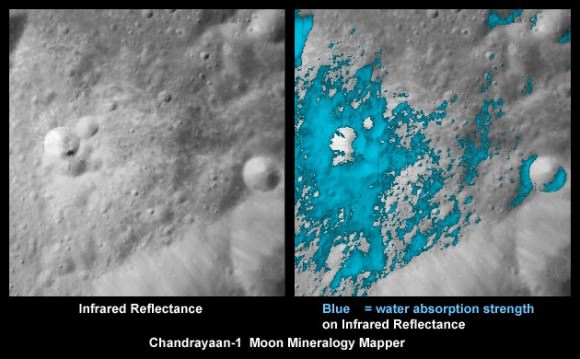
As noted, scientists have known for years that there are large amounts of frozen water in the Moon’s polar regions. At the same time, however, scientists have held that the Moon’s interior must have depleted of water and other volatile compounds billions of years ago. This was based on the widely-accepted hypothesis that the Moon formed after a Mars-sized object (named Theia) collided with Earth and threw up a considerable amount of debris.
Essentially, scientists believed that it was unlikely that any hydrogen – necessary to form water – could have survived the heat of this impact. However, as of a decade ago, new scientific findings began to emerge that cast doubt on this. The first was a 2008 study, where a team of researches (led by Alberto Saal of Brown University) detected trace amounts of water in samples of volcanic glass that were bought back by the Apollo 15 and Apollo 17 missions.
This was followed by a 2011 study (also from Brown University) that indicated how crystalline structures within those beads contained as much water as some basalt mineral deposits here on Earth. These findings were particularly significant, in that they suggested that parts of the Moon’s mantle could contain as much water as Earth’s. The question though was whether these findings represented the norm, or an anomaly.
As Milliken, an associate professor in Brown’s Department of Earth, Environmental, and Planetary Sciences (DEEPS) and the co-author on the paper, summarized in a recent Brown press release:
“The key question is whether those Apollo samples represent the bulk conditions of the lunar interior or instead represent unusual or perhaps anomalous water-rich regions within an otherwise ‘dry’ mantle. By looking at the orbital data, we can examine the large pyroclastic deposits on the Moon that were never sampled by the Apollo or Luna missions. The fact that nearly all of them exhibit signatures of water suggests that the Apollo samples are not anomalous, so it may be that the bulk interior of the Moon is wet.”
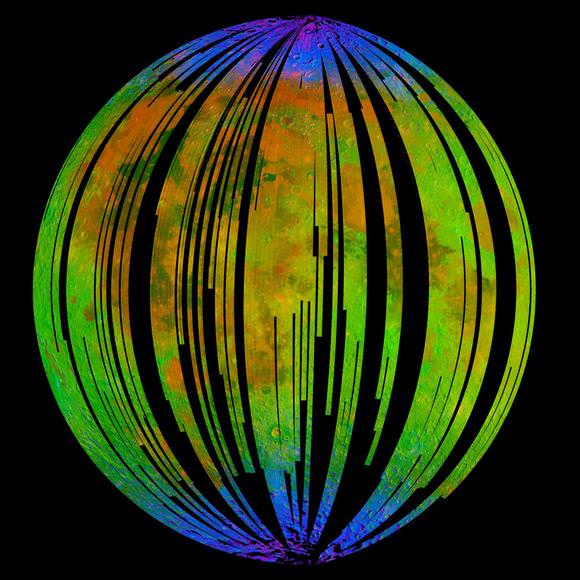
To resolve this, Milliken and Li consulted orbital data to examine lunar volcanic deposits for signs of water. Basically, orbiters use spectrometers to bounce light off the surfaces of planets and astronomical bodies to see which wavelengths of light are absorbed and which are reflected. This data is therefore able to determine what compounds and minerals are present based on the absorption lines detected.
Using this technique to look for signs of water in lunar volcanic deposits (aka. pyroclastic deposits), however, was a rather difficult task. During the day, the lunar surface heats up, especially in the latitudes where volcanic deposits are located. As Milliken explained, spectronomers will therefore pick up thermal energy in addition to chemical signatures which this can throw off the readings:
“That thermally emitted radiation happens at the same wavelengths that we need to use to look for water. So in order to say with any confidence that water is present, we first need to account for and remove the thermally emitted component.”
To correct for this, Milliken and Li constructed a detailed temperature profile of the areas of the Moon they were examining. They then examined surface data collected by the Moon Mineralogy Mapper, the spectrographic imager that was part of India’s Chandrayaan-1 mission. They then compared this thermally-corrected surface data to the measurements conducted on the samples returned from the Apollo missions.
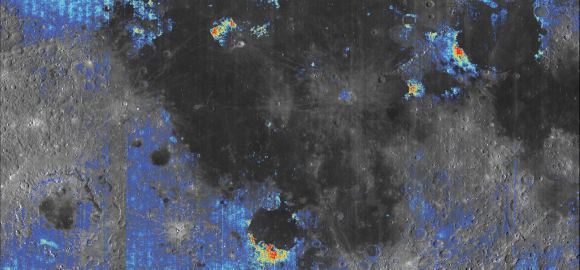
What they found was that areas of the Moon’s surface that had been previously mapped showed evidence of water in nearly all the large pyroclastic deposits. This included the deposits that were near the Apollo 15 and 17 landing sites where the lunar samples were obtained. From this, they determined that these samples were not anomalous in nature, and that water is distributed across the lunar surface.
What’s more, these findings could indicate that the Moon’s mantle is water-rich as well. Beyond being good news for future lunar missions, and the construction of a lunar settlement, these results could lead to a rethinking of how the Moon formed. This research was part of Shuai Li’s – a recent graduate of the University of Brown and the lead author on the study – Ph.D thesis. As he said of the study’s findings:
“The growing evidence for water inside the Moon suggest that water did somehow survive, or that it was brought in shortly after the impact by asteroids or comets before the Moon had completely solidified. The exact origin of water in the lunar interior is still a big question.
What’s more, Li indicated that lunar water that is located in volcanic deposits could be a boon for future lunar missions. “Other studies have suggested the presence of water ice in shadowed regions at the lunar poles, but the pyroclastic deposits are at locations that may be easier to access,” he said. “Anything that helps save future lunar explorers from having to bring lots of water from home is a big step forward, and our results suggest a new alternative.”
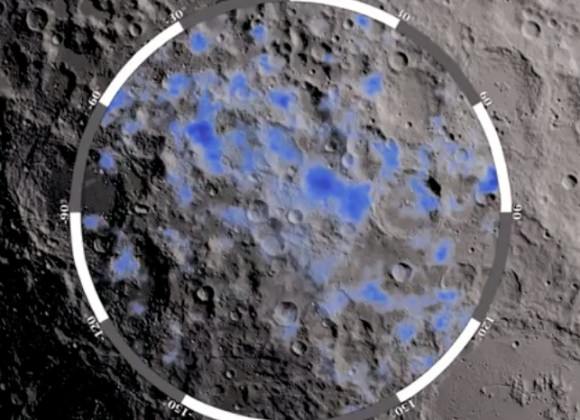
Between NASA, the ESA, Roscosmos, the ISRO and the China National Space Administration (CNSA), there are no shortage of plans to explore the Moon in the future, not to mention establishing a permanent base there. Knowing there’s abundant surface water (and maybe more in the interior as well) is therefore very good news. This water could be used to create hydrazine fuel, which would significantly reduce the costs of individual missions to the Moon.
It also makes the idea of a stopover base on the Moon, where ships traveling deeper into space could refuel and resupply – a move which would shave billions off of deep-space missions. An abundant source of local water could also ensure a ready supply of drinking and irrigation water for future lunar outposts. This would also reduce costs by ensuring that not all supplies would need to be shipped from Earth.
On top of all that, the ability to conduct experiments into how plants grow in reduced gravity would yield valuable information that could be used for long-term missions to Mars and other Solar bodies. It could therefore be said, without a trace of exaggeration, that water on the Moon is the key to future space missions.
The research was funded by the NASA Lunar Advanced Science and Exploration Research (LASER) program, which seeks to enhance lunar basic science and lunar exploration science.
Further Reading: Brown University

